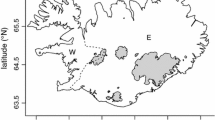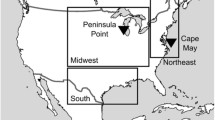Summary
The food hypothesis proposes that density dependent mortality regulates populations through food shortage. For Serengeti wildebeest, we found an empirical relationship between dry season adult mortality rate, density and food supply. This relationship predicted that: (1) the population would stabilize between 1.0 and 1.5 million animals, (2) dry season mortality would be density dependent and sufficient to account for the levelling off of this large ungulate population. Recent observations have tested and confirmed these predictions.
Similar content being viewed by others
References
Caughley G (1970) Eruption of ungulate populations with emphasis on Himalayan thar in New Zcaland. Ecology 51:53–72
Hilborn R, Sinclair ARE (1979) A simulation of the wildebeest population, other ungulates, and their predators. In: Sinclair ARE, Norton-Griffiths M (eds) Serengeti: Dynamics of an Ecosystem. Chicago University Press, Chicago p 287–309
Keith LB (1974) Some features of population dynamics in mammals. 11th Int Congr Game Biol (Stockholm) pp 17–58
Keith LB (1983) Role of food in hare population cycles. Oikos 40:385–395
Lack D (1954) The natural regulation of animal numbers. Clarendon Press, Oxford
Lack D (1966) Population studies of birds. Clarendom Press, Oxford
McCullough DR (1979) The George Reserve deer herd. University of Michigan Press, Ann Arbor
Norton-Griffiths M (1973) Counting the Serengeti migratory wildebeest using two-stage sampling. E Afr Wildl J 11:135–149
Plowright W, McCulloch B (1967) Investigations on the incidence of rinderpest virus infection in game animals of N. Tanganyika and S. Kenya, 1960–63. J Hyg (Camb) 65:343–358
Sinclair ARE (1973) Population increases of buffalo and wildebeest in the Serengeti. E Afr Wildl J 11:93–107
Sinclair ARE (1975) The resource limitation of trophic levels in tropical grassland ecosystems. J Anim Ecol 44:497–520
Sinclair ARE (1977) The African Buffalo. Chicago University Press, Chicago
Sinclair ARE, Duncan P (1972) Indices of condition in tropical ruminants. E Afr Wildl J 10:143–149
Sinclair ARE, Norton-Griffiths M (eds) (1979) Serengeti: Dynamics of an ecosystem. Chicago University Press, Chicago
Sinclair ARE, Norton-Griffiths M (1982) Does competition or facilitation regulate migrant ungulate populations in the Serengeti? A test of hypotheses. Oecologia (Berl) 53:364–369
Talbot LM, Talbot MH (1963) The wildebeest in western Masailand. Wildl Monogr 12, The Wildlife Society, Washington DC
Taylor WP, Watson RM (1967) Studies on the epizootiology of rinderpest in blue wildebeest and other game species of northern Tanzania and southern Kenya, 1965–67. J Hyg (Camb) 65:537–545
Author information
Authors and Affiliations
Rights and permissions
About this article
Cite this article
Sinclair, A.R.E., Dublin, H. & Borner, M. Population regulation of Serengeti Wildebeeest: a test of the food hypothesis. Oecologia 65, 266–268 (1985). https://doi.org/10.1007/BF00379227
Received:
Issue Date:
DOI: https://doi.org/10.1007/BF00379227




